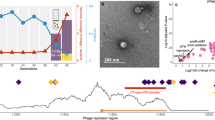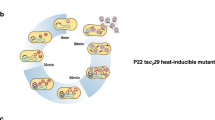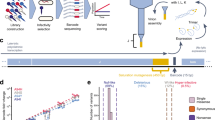Abstract
THE evolutionary basis for the integration of phage DNA into bacterial chromosomes (lysogeny1,2) is not understood. A generally accepted explanation is that when the bacterial population is large and growing well, the phages prefer the lytic pathway since they can multiply without elimination of all host bacteria. If conditions deteriorate so that the supply of bacteria becomes limited or if growth is slowed, the phages tend to lysogenise. There have been few studies of the evolutionary mechanisms which may have selected for lysogeny. We now report that in certain growth conditions λ lysogens of Escherichia coli reproduce more rapidly than isogenic, non-lysogenic strains.
This is a preview of subscription content, access via your institution
Access options
Subscribe to this journal
Receive 51 print issues and online access
$199.00 per year
only $3.90 per issue
Buy this article
- Purchase on Springer Link
- Instant access to full article PDF
Prices may be subject to local taxes which are calculated during checkout
Similar content being viewed by others
References
Lwoff, A., Bact. Rev., 17, 269–337 (1953).
Echols, H., A. Rev. Genet., 6, 157–190 (1972).
Sussman, R., and Jacob, F., C.r. hebd. Séanc. Acad. Sci., Paris., 254, 1517–1519 (1962).
Sly, W., Eisen, H., and Siminovich, L., Virology, 34, 112–127 (1968).
Van Brunt, J., and Edlin, G., J. molec. Evol. (in the press).
Author information
Authors and Affiliations
Rights and permissions
About this article
Cite this article
EDLIN, G., LIN, L. & KUDRNA, R. λ Lysogens of E. coli reproduce more rapidly than non-lysogens. Nature 255, 735–737 (1975). https://doi.org/10.1038/255735a0
Received:
Accepted:
Issue Date:
DOI: https://doi.org/10.1038/255735a0
This article is cited by
-
Spontaneously induced prophages are abundant in a naturally evolved bacterial starter culture and deliver competitive advantage to the host
BMC Microbiology (2018)
-
Shigatoxin encoding Bacteriophage ϕ24B modulates bacterial metabolism to raise antimicrobial tolerance
Scientific Reports (2017)
-
Cold adaptation regulated by cryptic prophage excision in Shewanella oneidensis
The ISME Journal (2016)
-
A new perspective on lysogeny: prophages as active regulatory switches of bacteria
Nature Reviews Microbiology (2015)
-
Disentangling the relative influence of bacterioplankton phylogeny and metabolism on lysogeny in reservoirs and lagoons
The ISME Journal (2011)
Comments
By submitting a comment you agree to abide by our Terms and Community Guidelines. If you find something abusive or that does not comply with our terms or guidelines please flag it as inappropriate.



